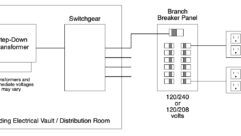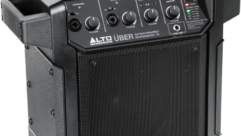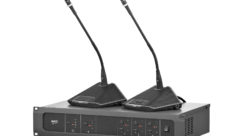AC 2 DC
May 1, 2001 12:00 PM,
Glen Ballou
We take power supplies for granted except when they are missing or broken. But where would any of our audio and video applications be without them? Dead in the water.
WE TAKE POWER SUPPLIES FOR GRANTED except when they are missing or broken. But where would any of our audio and video applications be without them? Dead in the water. So let’s take a look at the basics behind the power supplies we use.
Power supplies can be DC power supplied directly from a battery, or DC power converted from an AC source. The latter is the one we use the most. AC-to-DC power supplies are either half- or full-wave, and either direct-coupled or transformer-isolated. The most common AC-to-DC power supplies in our business are the transformer-isolated, full-wave center tap and the full-wave bridge circuit.
HALF-WAVE SUPPLY
The simplest circuit is a one-half wave supply where a rectifier is placed in series with the load. This supply will always have poor regulation and transient response. The rectifier can be connected directly off the AC mains (as in Figure 1A), or off the mains through a transformer (Figure 1B).
The rectifier only passes a current when the anode is more positive than the cathode, so the output waveform is one-half of a sine wave (Figure 1C). The characteristics of this simple circuit can be found in Table 1. When the power supply is connected directly across the mains without a transformer, it can be dangerous to both the operating personnel and to the grounded equipment and can cause hum problems that can only be solved with an isolating transformer between the line and power supply.
FULL-WAVE SUPPLY
A full-wave supply is used with a transformer unless it is connected across an AC circuit where both legs are floating to ground. It may be either a center tap or a full-wave bridge design. Both the positive and negative cycles are rectified and mixed to produce DC output, as shown in Figure 2C.
The center-tap configuration, seen in Figure 2A, uses two rectifiers and a center-tapped transformer. The VDC is approximately equal to VAC from one side of the transformer to the center tap. Each rectifier carries one half of the load current.
A full-wave bridge rectifier supplies full-wave rectification without a center-tapped transformer. A full-wave bridge rectifier consists of four rectifier elements (Figure 2B). This circuit is among the most familiar and is the one most commonly employed in our industry. With the full-wave bridge circuit, the DC output voltage is equal to about 0.9 of the RMS value of the AC input voltage across the secondary of the transformer.
Bridge rectifier circuits may be grounded by either grounding the input (AC source), as in Figure 3A, or the output (DC load), as in Figure 3B. Or, if it is transformer-isolated, both AC and DC sides of the circuit may be grounded, as in Figure 3C.
The peak inverse voltage applied to the rectifier is a common cause of rectifier failure. If the required PIV rating is not available for a power supply and rectifier that you are servicing, two or more may be connected in series to obtain the desired PIV rating. Unequal values of PIV ratings may be used, provided the lowest rating is greater than half of the total PIV rating needed. You can calculate rectifier PIV from Table 1.
Rectifiers can be used in parallel to obtain higher current ratings. However, if the rectifier characteristics are not identical, one unit may carry more current than the other and could conceivably fail. To prevent this, small equal-value resistors are connected in series with each individual rectifier to balance the load currents.
FILTERS
Power supplies almost always employ filters to reduce the output ripple and produce a low-impedance AC return for the load. The filter is a series of resistors, capacitors and inductors inserted between the rectifiers and the load to reduce the AC or ripple component of the DC output. Figure 4 shows a few examples.
The capacitor filter (Figure 4A) has a capacitor across the output of the rectifiers, which attempts to charge to the peak value of the sine wave on each cycle. This happens because the voltage across the capacitor rises nearly as fast as the rectified pulse. As the rectifier output drops on each cycle, the voltage across the capacitor does not fall to zero but gradually diminishes until another pulse from the rectifier is applied to it and it again charges to the peak voltage.
The capacitor may be considered a kind of storage tank, storing up energy to the load between pulses. Capacitor filters operate best with large-value capacitors and high-resistance loads. As the load resistance is lowered, the ripple increases and regulation decreases.
An inductive filter employs a choke rather than a capacitor at the input of the filter (Figure 4B). The output voltage from an inductive filter is lower than a capacitor filter but has better voltage regulation.
A choke filter operates best with maximum current flow and has no effect on a circuit when current is not flowing. An inductor filter depends on the property of an inductor to oppose any change of current.
Inductance-capacitance (LC) filters, sometimes called L filters, use an inductor as an input filter and a capacitor as the second stage of the filter (Figure 4C). LC filters operate well under varying load conditions.
The inductive reactance of the choke tends to oppose any change in the current flowing through the winding, creating a smoothing action on the pulsating current of the rectifier. The capacitor stores and releases electrical energy, further reducing ripple. The result is reasonably smooth output current.
A resistance-capacitance (RC) filter (Figure 4D) employs a resistor and capacitor rather than an inductor and capacitor reducing cost, weight and magnetic fields. The disadvantage is that the series resistance has a voltage drop across it that could be detrimental to the circuit operation. An RC-filter system is generally used only where the current demands are low and constant.
A pi (š) filter has a capacitor input followed by an LC section filter (Figure 4E). Pi filters have a smooth output and poor regulation. They are often used where the transformer voltage is not high enough and low ripple is required. By using the input capacitor, the DC voltage is boosted to peak.
VOLTAGE DIVIDERS
One circuit we often forget about is a resistance voltage divider. The dropping resistors can be calculated by means of Ohm’s law (R=V/I). The wattage can be computed by P=V2/R or I2R. Remember that each section should have a separate bypass capacitor to ground. The bypass capacitors stabilize and improve the filtering and decouple the various levels.
The voltage divider shown in Figure 5 supplies three voltages to the system’s external devices. The lower circuit supplies load L1, the second circuit supplies L2 and the top circuit supplies L3. All three circuits are common to ground.
The total current required from the power supply is the total current of the three external circuits, or IL1 + IL2 + IL3, plus an additional current called the bleeder current. This bleeder current flows only through the resistors and not through the external circuits. It’s generally 10% of the total current.
Resistor R1 is calculated first. Because only bleeder current flows through this resistor, it may be calculated as follows: R1= V/I, where V is the L1 voltage also across R1 and I is the bleeder current. The voltage at the top of R2 is the L2 voltage to ground. Subtracting the voltage drop across R1 results in a voltage across R2. The current through R2 is the current of load L1 plus the bleeder current:
Resistor R3 has the current of loads L1 and L2 plus the bleeder current flowing through it or:
Since the current of load L3 does not flow through the voltage-divider, it requires no further consideration.
When working with audio and video applications, these power-supply basics can prove key to a job well done. Don’t take power for granted.
Glen Ballou works with Innovative Communications Inc. and is the author of The Handbook for Sound Engineers: The New Audio Cyclopedia.
Testing Circuits: The Tools of the Trade
Simple power supplies can be tested with simple instruments. An AC-DC voltmeter will tell if the rectifiers are operational and if the output level is correct. An ohmmeter placed across the rectifiers will reveal if the rectifier is open or shorted. (At least one side of the rectifier must be disconnected from the circuit to obtain a proper reading.) An ammeter will show the current flow in the various legs of the circuit. An oscilloscope across the output shows ripple and whether the AC signal is being shorted to ground through the filter: a good indicator of the condition of the filter capacitor.










